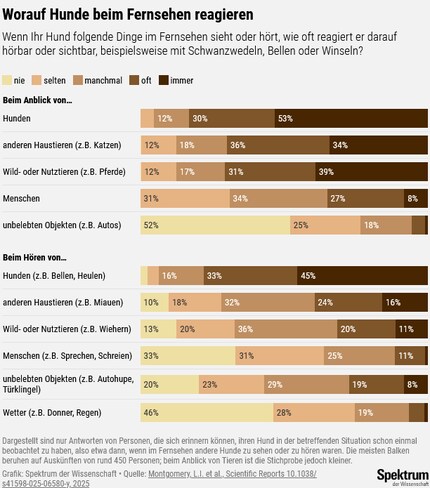
What dogs like to watch on television
As soon as the television comes on, many dogs seem to doze off indifferently. But they can obviously recognise what they see and hear.
Dogs also have favourite shows: They find it most exciting when it's about conspecifics or other animals. This was the result of a study in the USA presented in the «Scientific Reports». Psychologist Lane Montgomery and her colleagues from Auburn University in Alabama surveyed more than 450 people online about the behaviour of their dogs when the television was on. On a scale from «never» to «always», the owners were asked to indicate how often their pets barked when they heard animal sounds or changed their posture when they saw moving dogs.
88 per cent of respondents stated that their dog reacted to the programme at least occasionally, for example by staring at the screen, barking or wagging its tail. The four-legged friends responded primarily to conspecifics, other pets or wild animals, but less so to people or objects. Whether a dog saw a conspecific or merely heard barking apparently made no difference. According to the owners, the visual stimuli that attracted the most attention were movements.
The reactions could be statistically assigned to three categories. Firstly, the animals showed a more or less pronounced tendency to follow the stimuli on the screen, regardless of the programme. Secondly, they also tended to react either more or less to different types of animals. And thirdly, the same applied to people and objects - measured by the behaviour of the four-legged friends, these thus formed a common category. The age of the dogs, whether they were male or female and which breed group they belonged to, such as hunting or herding dogs, made no particular difference to the reactions. Temperament, on the other hand, did make a difference: those animals that, according to their owners, were generally prone to strong negative arousal were more intensely engaged with the television images.

The researchers did not ask how much the dog was kept busy and occupied in everyday life, as they admit: such factors could influence television viewing behaviour. In addition, only a few people whose dogs have little or no reaction to television took part in the study; they could therefore be underrepresented in this study. And finally, it remains to be seen whether the owners interpreted their dogs' behaviour correctly at all. Nevertheless, the researchers believe they can conclude from the responses that television can be more than just background noise for dogs: A suitable «dog television programme» could, for example, provide dogs in animal shelters with some variety.
Spectrum of Science
We are partners of Spektrum der Wissenschaft and want to make well-founded information more accessible to you. Follow Spektrum der Wissenschaft if you like the articles.
Original article on Spektrum.de
Experts from science and research report on the latest findings in their fields – competent, authentic and comprehensible.
From the latest iPhone to the return of 80s fashion. The editorial team will help you make sense of it all.
Show all